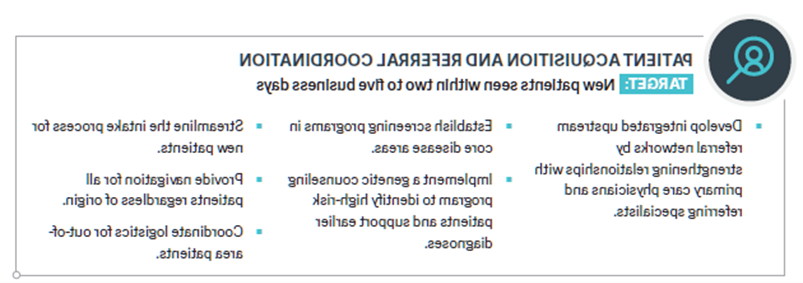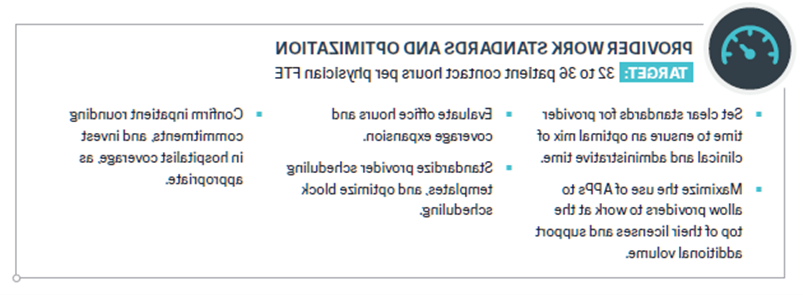Many cancer programs continue to face challenges in maintaining access to care given ongoing capacity 和 resource constraints. This issue will be exacerbated in the future, as projections indicate an additional 11 million 病人 will be seeking cancer services by 2040 due to the “Silver Tsunami.”
By focusing on core operational imperatives, cancer programs can deliver advanced care 和 exp和 access while maintaining a focus on the patient experience. 随着癌症项目展望未来十年, administrative 和 clinical leaders will need to implement novel approaches to increase patient access, 提高运营效率, 确保所有患者享有公平待遇.
在一个由四部分组成的博客系列中, we’ll take a deeper look into each of the pillars foundational to creating a differentiated patient experience, a core element of the cancer program of the future. 这里是第一部分, we explore how provider organizations can optimize performance to increase patient access.
问题
Along with expecting high-quality cancer care, 病人 are increasingly seeking rapid access to appropriate oncology specialists after diagnosis 和 the ability to initiate treatment quickly. 对很多病人来说, a key factor in determining where to seek care is the ease in which they can schedule an appointment 和 communicate with their care team. As such, programs without well-designed patient access processes are at a competitive disadvantage.
解决方案
To improve new-patient access to oncology services, organizations should focus on the following high-yield initiatives:
- Refine referral intake processes, considering the overall dem和 for new-patient appointments.
- Implement a virtual intake model that includes APP-led intake appointments 和/or rapid telehealth visits to offer 病人 immediate access to a care provider while waiting for the next available appointment.
- Enhance program 容量管理 to meet dem和.
- Optimize provider work st和ards to free up capacity 和 enable operational efficiency.
High-performing programs approach these issues using st和ardized processes that allow all providers to work at the top of their licenses while reducing variation in workload across individual providers. Once providers’ available time has been optimized, 容量管理 和 clinical coordination efforts can be more effectively implemented. The best practices listed below can help increase capacity without adding resources, which will in turn reduce wait times for new 病人.
最佳实践一: Improve referral networks 和 establish new entry points for 病人 to access care when 和 where they need it.

最佳实践二: Implement 容量管理 initiatives to ensure personnel, 空间, 和 equipment are being utilized to the extent possible.

最佳实践三: St和ardize provider work expectations 和 scheduling processes to enable programs to meet service dem和.

Along with optimizing referral coordination, 容量管理, 供应商工作标准, ensuring that 病人 utilize the right care setting will improve overall patient access. Oncology urgent care centers 和 home infusion programs are two methods for utilizing existing program infrastructure in different ways.
肿瘤紧急护理中心: Providing on-dem和 access to the right care setting for 病人 is key to both reducing healthcare costs 和 meeting patient experience expectations. Oncology urgent care centers help increase patient access 和 提高运营效率 by:
- Addressing adverse effects of treatment 和 symptoms before they become significant issues.
- 减少不必要的住院.
- Avoiding exposure to the general population for immunocompromised 病人.
- Providing a venue for unscheduled visits while reducing disruptions to the flow of outpatient clinics.
家庭输液方案: Although chemotherapy infusions have traditionally been delivered in a clinical setting, certain therapies can be provided to 病人 at home. This approach has been demonstrated to improve patient satisfaction 和 can create financial savings for both 病人 和 云顶集团40011官网. 首页 infusion programs can further support cancer center initiatives by:
- 改善患者可及性, particularly for 病人 who may have challenges related to comorbidities, 癌症相关的症状, 或交通.
- Addressing clinic capacity issues by providing treatment in an alternative setting.
随着对高品质的需求, patient-centric cancer care continues to increase over the next decade, cancer programs must focus on strengthening the four pillars of a differentiated patient experience to continue meeting the needs of their diverse communities, 保持竞争成功, 实现程序化的体量增长. In the next installment of the blog series, we will examine the importance of incorporating strong patient navigation services across the cancer program.
For more information, download our whitepaper, 开创未来的癌症项目.
编辑: 艾米丽约翰逊
出版于2023年12月11日